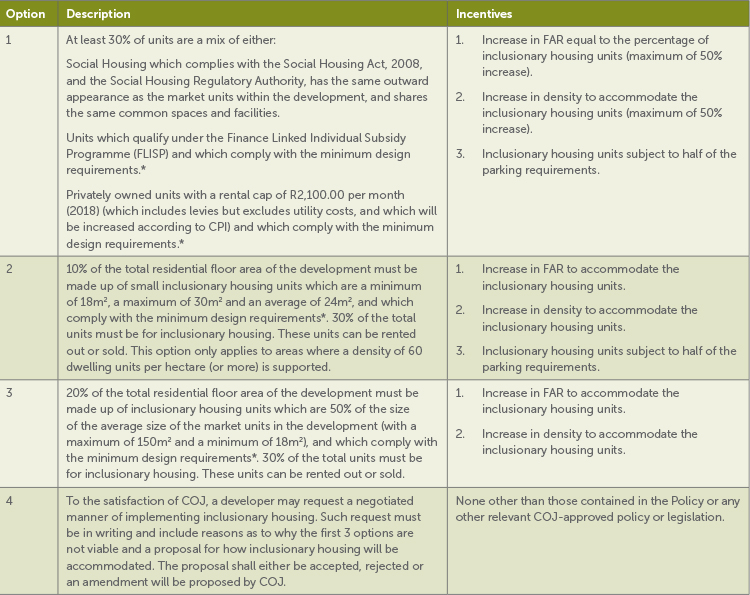The City of Johannesburg Inclusionary Housing Policy, 2019
The Policy has a number of objectives which it aims to achieve, some of which include:
- addressing social inequalities in Johannesburg and the significant backlog in the provision of affordable housing to low income households;
- ensuring that lower income residents move closer to employment opportunities and social amenities;
- ensuring that the increase in property value which ensues as a result of the award of development rights is enjoyed not only by the developer, but also by the City and its residents; and
- enabling the City to ensure that its investments benefit large and diverse portions of the population which will in turn effect spatial transformation.
Inclusionary housing is to be seen as a mechanism that would facilitate a move towards a more inclusive, efficient and effective city.
The Policy sets out the requirements and conditions for inclusionary housing and details the different options available for implementing same, together with the “incentives” made available to developers in return. The Draft Policy only provided for one manner in which to implement the policy together with one set of incentives. The Policy also provides for an Excel spreadsheet “calculator”, which developers can use to determine which option would suit them best.
The Policy defines inclusionary housing as:
“a housing programme that, through conditions attached to land use rights approvals, requires private developers to dedicate a certain percentage of new housing developments to low income and low middle income households, or to households that may not otherwise afford to live in those developments.”
Inclusionary housing is mandatory for any development within the jurisdiction of COJ, which proposed development includes 20 dwelling units or more. This reflects an increase from a minimum development size of 10 units in terms of the Draft Policy.
There are four different options for the implementation of inclusionary housing, as further discussed below, however, in each option, a minimum of 30% of the total units in the development must be set aside for inclusionary housing, which units must be located on the same site as the remainder of the development or within the same township. This shows an increase from the 20% requirement set out in the Draft Policy. Furthermore, in terms of the Draft Policy, inclusionary housing was limited to rentals, but the Policy has also included the implementation of inclusionary housing though ownership of such units.
From the date that the Policy takes effect, each new land development application will be required to provide for inclusionary housing and the implementation thereof will be made a condition of approval of the development. Such conditions will be in place in perpetuity or until repealed by a COJ resolution. Action may be taken by COJ against the developer should these conditions not be complied with. The provisions of the Policy will not affect existing approved land use rights. If and when COJ considers it necessary, the Policy will be reviewed and amended accordingly.
Below follows a summary of the four options available to developers for the implementation of inclusionary housing:

*Minimum Design Requirements:
- Private bathroom.
- Minimum of 7m2 of habitable space per person and minimum of 18m2 per unit (this is an increase from the 15m2 provided for in the Draft Policy).
- Have the same outward appearance as the market units in the development.
- Share the same common spaces and facilities as the market units in the development.
What should be noted is that, as opposed to the Draft Policy, the Policy makes no mention of incentives relating to decreased parks or engineering service contributions in respect of the inclusionary housing units, building line relaxation, or property rate rebates applicable to such units.
Although there has been much negative feedback given by developers and interested parties in relation to the Draft Policy and the Policy in its final form, including the financial viability and practicality thereof, developers will have to ensure that the Policy is implemented, in one way or another, failing which they will not be in a position to proceed with their proposed residential developments as intended.
The information and material published on this website is provided for general purposes only and does not constitute legal advice. We make every effort to ensure that the content is updated regularly and to offer the most current and accurate information. Please consult one of our lawyers on any specific legal problem or matter. We accept no responsibility for any loss or damage, whether direct or consequential, which may arise from reliance on the information contained in these pages. Please refer to our full terms and conditions. Copyright © 2026 Cliffe Dekker Hofmeyr. All rights reserved. For permission to reproduce an article or publication, please contact us cliffedekkerhofmeyr@cdhlegal.com.
Subscribe
We support our clients’ strategic and operational needs by offering innovative, integrated and high quality thought leadership. To stay up to date on the latest legal developments that may potentially impact your business, subscribe to our alerts, seminar and webinar invitations.
Subscribe




